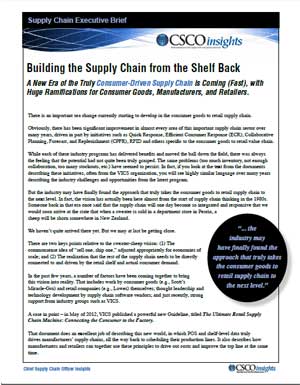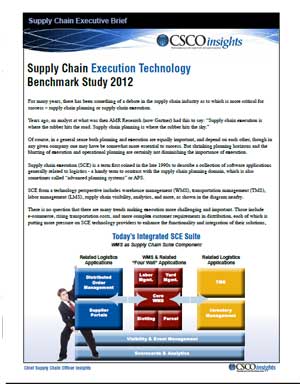 |
November 8, 2012 - Supply Chain Newsletter |
 |
FEATURED SPONSOR - Logility |
 |
New Whitepaper Available for Download from Logility
|
 |
|
|||||||||||||||||||||||||||||||||||||
Multi-Channel Commerce and the Supply Chain
|
||||||||||||||||||||||||||||||||||||||
| GILMORE SAYS: |
"I have been told by a couple of very knowledgeable retail industry insiders that the dot com groups of many retailers are bleeding substantial red ink, like losses of 20-30% in some cases." WHAT DO YOU SAY? |
That means that e-commerce sales, which have seen strong growth for more than a decade, are still doubling every four years or so.
The Census Bureau further says that from Q2 2011 to Q2 2012, e-commerce sales rose from about $47.5 billion to $54.8 billion, a gain of $7.3 billion or 15.3%.
But I don't think that can be correct - Amazon.com alone is growing faster than that in dollar terms. Amazon has grown from $14.8 billion in sales in 2007 to $48.1 billion in 2011. That translates to 225% top line growth in just four years. It grew to that $48.1 billion in 2011 from $34.2 billion in 2010, absolute growth of $13.9 billion, with a percentage growth of 40%. Some of that growth is certainly in 3PL services and its cloud platform, but the majority is in goods, which is why I question the government numbers cited above. The total growth has to be more than that.
Amazon has recently "slowed down" to just 30% or so quarterly growth. It should end the year with more than $60 billion in sales. It likely will become the number 2 US retailer by sales behind Walmart in just 2-3 years.
Just picking out a much less well known retailer, Hudson's Bay Co., the Canada-based parent company of department store Lord & Taylor, recently said it expects its e-commerce sales to rise 70% in 2012 to $142 million, after rising 87% in 2011.
E-commerce, however, is now part of the whole "multi-channel commerce" phenomenon. Multiple paths of purchase and delivery. Buy anywhere, pick up anywhere. More sales and delivery channels are coming too: your television...vending machines...what else?
A senior supply chain executive from one of the country's largest retailers told me at a dinner this Spring that "multi-channel is going to create big winners and losers" in the retail sector, depending on the decisions and investments each merchant makes. One of the weird things here is how technology driven this all is. The CIO of Brooks Brothers said at the NRF conference back in January that they were racing hard to get to "order on-line, pick-up in store" but they just hadn't built the IT capabilities to handle that kind of order yet. Hope to have it soon, he added wistfully.
 Of course, this is not only a retailer phenomenon. Manufacturers and wholesalers of all sorts are dealing with many of the same e-commerce/multi-channel supply chain challenges and questions. How aggressive do we go? Will we tick off our channels? Do we insource or outsource e-fulfillment operations? If we insource it, do we use an existing DC, or a separate fulfillment operation? Etc.
Of course, this is not only a retailer phenomenon. Manufacturers and wholesalers of all sorts are dealing with many of the same e-commerce/multi-channel supply chain challenges and questions. How aggressive do we go? Will we tick off our channels? Do we insource or outsource e-fulfillment operations? If we insource it, do we use an existing DC, or a separate fulfillment operation? Etc.
Now, the even larger question is this: Is anyone making any money at it? We have total price transparency, resulting in razor thin margins. Add to that market and consumer pressure to deeply discount or give away shipping. Amazon, by the way, basically broke even in Q2 after growing revenue 30% in the quarter. I have been told by a couple of very knowledgeable retail industry insiders that the dot com groups of many retailers are bleeding substantial red ink, like losses of 20-30% in some cases.
I saw another presentation earlier this year by a former retail logistics executive for department store chain Belks who had managed e-fulfillment operations but was now running a 3PL. He went through a laundry list of penny-pinching areas often overlooked in e-fuflillment, from details of call center scheduling to packaging minutia. Don't focus on this stuff, he said, and you just can't make a sufficient profit in e-commerce. I will just say that compared to most cost conscious DCs, this was a whole new level of cost reduction focus. You literally are looking for fractions of a penny.
I actually planned for this column to in part summarize the research we have been doing lately on a slew of announcements relative to e-fulfillment, especially same day shipping. But I can't squeeze that in here. I will do that in the next two weeks. So for now, I am just going to summarize a few of the key issues the supply chain faces with multi-channel:
1: Should you do e-fulflillment in the same DC that is replenishing stores (retailers) or shipping to channels (manufacturers/ wholesalers) or a separate operation? My friend Jim Barnes of enVista, who works with many retail distribution operations, knows more about this question than I do, has this to say.
"We like the idea of combining the dot com and retail distribution operation if and only if the retailer has the ability to consolidate reserve inventory but logically keep it separated using a Distributed Order Management (DOM) or what I like to refer as enterprise commerce flow (ECF)," Barnes says. "In principle we liked them combined, but many retailers don't know how to do it, therefore you see a lot of physical or virtual fences separating dot com from retail order distribution."
We are greatly shortening his comments here, which will appear next week in full in our On-Target newsletter, but Barnes notes on the other hand that "The bigger question is regarding service and this is why there is a strong argument against combining retail and B2C. I believe to keep up with Amazon retailers are going to be required to establish more satellite or spoke locations in larger demographic areas that allow the retailers to service customer same day, at worst case next day."
(2) How can shipping costs be managed? Discounted/free shipping is sapping the profits out of e-commerce. The consensus at an NRF panel in January was it was getting worse and driving towards free all the time.
During that panel, Overstock.com's CEO Patrick Byrnes noted that even though the web merchant charges only $2.95 for shipping, it sees a clear sales lift when it drops shipping to just $1.00. Byrnes also warned that when such shipping promotions are ended, sales for a while actually drop down below the baseline, and that free shipping inevitably drops the size of the consumer's cart compared with having a minimum required for free shipping.
Mike Marlowe of 3PL Kane is Able recently told us that the double shipping costs (manufacturer to retail DC to consumer) is a big part of the issue, but does the manufacturer want to invest in B2C capabilities for drop shipping for the retailer? What if the retail customer orders several items across vendors? This is like a catch 22. Marlowe also suggested looking for opportunities to use freight already moving to an area to get that needed for e-fulfillment closer to the customer.
(3) How to manage multi-channel inventories? Is anyone really doing this well yet? In 1999, a manager at LL Bean offered me a great vision of a inventory allocation solution that would keep tabs on forecasts by channel, sales over a month against the forecast, dynamically moving inventory across channels based on that, and/or placing a penalty on a channel that under-forecast if it needed to "buy" inventory from another channel that had got it right.
I don't think anyone has really built it yet, although some of the Distributed Order Management solutions are getting close.
I have covered a lot of ground in I realize a somewhat helter-skelter fashion. This is another inflection point in our supply chains. Market positions will be won and lost, based on supply chain and logistics.
More soon.
What's your reaction to Gilmore's comments on e-fulfillment? Can the dot come channel make money given logistics costs? Will multi-channel create winners and losers? Let us know your thoughts at the Feedback button below.
![]()
| View Web/Printable Version of this Page |
|
|
|
YOUR FEEDBACK
Trying to catch up on the many feedbacks we received. This week, our Feedback of the week goes to Arun Kumar Ojha of Schlumberger, who says that the growing use of temporary labor in US factories is not surprising, given US manufacturers haven't worked smart enough to keep themselves competitive globally.
We also have several letters relative to Dan Gilmore's First Thoughts column on Taming the Long Tail.
Feedback of the Week: On Increased Use of Temp Labor
With increase in temporary labour in manufacturing system, it brings more flexibility in scalability but at the same time it brings in lower accountability to individuals. One need to look at the business requirements in detail and deploy temporary labors in the system. US manufacturing organizations have been traditionally bulkier without performance based incentives, which has resulted in becoming less cost competitive. On top of that, the US kept believing on buying of low cost country like China, instead of focussing on bringing in efficiency, lowering cost structure, improving productivity, and bringing flexibility in supply chain in manufacturing sectors. It is too late to revive the manufacturing sector now in US. The organizations need to think all corners to bring overall cost down to be more competitive in today's economic scenario. Temporary labour is just fragment of this process.
Arun Kumar Ojha Asia Global SourcingSchlumberger |
||
| Feedback on Taming the Long Tail | ||
Thanks for covering this topic. I look forward to hearing more details on your approach to this issue. While your article was around retail inventory, I feel that the approach you use to model will probably be ok for my spare parts inventory. We segment our inventory in many layers but I'm always looking for better approaches for the "quantity and frequency of demand". Ron Whitlock
|
||
The long tail can be divided into two pieces: • Low volume /low variability (the "Steady Eddies") Each can and should be treated differently. High variability leads itself to producing to demand while the low variability can easily be forecast. Many CPG companies have taken this one step further... adding production capacity, they have utilized produce-to-demand in both high volume / low variability products and high volume/high variability products. One of our clients has pushed their "A" item inventory to 3 days supply - and their biggest clients are this you would identify as ultimately demanding.
|
||
Amazon is doing a pretty good job with their long tail strategy - but, they have vulnerabilities. Richard J Sherman, president & CEO |
SUPPLY CHAIN TRIVIA ANSWER
Q: About what percent of US truckload carrier revenue comes from fuel surcharges?
A: Of late (it varies of course) somewhere between 2-3%. Werner's fuel surcharge revenues were 2.8% of trucking revenues in Q3, for example; at Heartland Express, they were 2.0%.
| © SupplyChainDigest™ 2003-2012. All Rights Reserved. SupplyChainDigest PO Box 714 Springboro, Ohio 45066 |
POWERED BY: XDIMENSION
|








